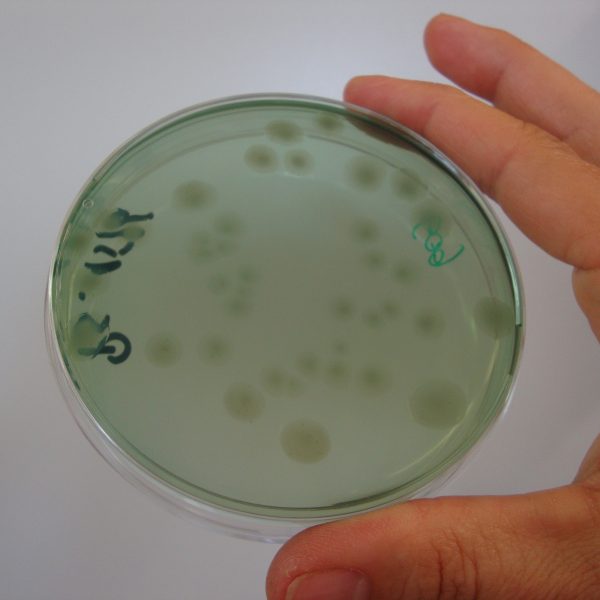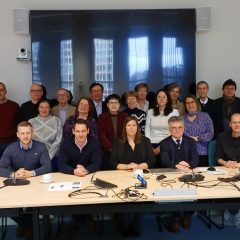Dossier Food: Food safety
ILVO has many years of experience in the field of chemical and microbiological food safety. For the analysis of finished food products, raw materials, ingredients, (semi)manufactured products, residues and by-products, ILVO has the necessary equipment and expertise and this for numerous components such as residues and contaminants (e.g. Toxins), spoilage organisms, and food pathogens.
Food Pilot
What does ILVO do?
-
 Veterinary drug residues, toxins of (micro-)organisms, allergens, anti-nutritional factors, PAHs, metals, microplastics, ...
Veterinary drug residues, toxins of (micro-)organisms, allergens, anti-nutritional factors, PAHs, metals, microplastics, ... -
 Screening and confirmation methods using chromatography methods coupled with mass spectrometry, fluorescence and UV detection, ...
Screening and confirmation methods using chromatography methods coupled with mass spectrometry, fluorescence and UV detection, ... -
Microbiological spoilage organisms, microbiological hygiene indicators, pathogenic microorganisms (pathogens)
-
 Classical microbiological analyses, genetic typing and characterization, metagenetics and whole genome sequencing
Classical microbiological analyses, genetic typing and characterization, metagenetics and whole genome sequencing
Food safety and quality above all
Food safety and food quality are basic requirements within a nutritionally balanced diet. Food safety is the guarantee that our food does not contain harmful substances or pathogens, whereas food quality ensures that our food remains sufficiently fresh and storable without signs of spoilage or loss of nutritional properties, as well as being tasty. Both aspects are important within a sustainable food system and always deserve our full attention.
What can make our food unsafe?
Every year, millions of people worldwide fall ill from microorganisms associated with food. Major foodborne pathogens include protozoa, viruses (e.g. norovirus), and bacteria such as Campylobacter, Salmonella, Listeria monocytogenes, and shiga-toxin-producing Escherichia coli.
In terms of chemical contaminants and residues in food, the adverse effects tend to be chronic rather than acute. Toxicity of the component, the degree and duration of exposure therefore determine their harmfulness to consumers. Examples include contaminants such as mycotoxins, plant toxins and heavy metals.
Animal drugs, plant protection products, migration components from inks or glues, ... are examples of substances that can lead to the presence of residues in food products. Both for certain microbiological agents and contaminants and residues, standards or limits have been established in Europese (en in mindere mate in nationale) regel- of wetgeving
To guarantee safe food
Food-related outbreaks, crises and/or scandals in the past - with the fipronil crisis in eggs as the freshest in Belgian memory - repeatedly underscore the need to permanently guarantee food safety for consumers. Guaranteeing food safety in practice always and everywhere is not an obvious or simple task. The various links in the agri-food system must all take responsibility, from the producer and processor to the consumer (field-to-fork concept), from policy makers and legislators to control bodies. ILVO is committed to developing and validating sensitive analyses, performing well-supported scientific research, and communicating about food safety based on that research within the context of microbiological as well as chemical food safety.
Chemical and microbiological food safety
Besides food quality aspects such as optimal nutritional composition, sensory aspects, texture and functionality, chemical and microbiological food safety are important focal points within food production. ILVO, with its extensive analytical measurement platform, provides the necessary up-to-date expertise and capacity to determine these aspects from primary product to final product.
Analysis techniques
ILVO uses the more traditional techniques (e.g. bacteriological techniques via culture, screening methods, LC-MS/MS methods) as well as more recently introduced concepts such as "-Omics" approaches and techniques such as Whole-genome sequencing (WGS) and untargeted (non-targeted) analytical techniques ( high resolution mass spectrometry (HRMS) - and near infrared spectroscopy (NIR) , MALDI-TOF, ...). The capacity to perform all of these analyses is part of the application and analysis center of the Food Pilot established by Flanders’FOOD and ILVO, where food processing on a semi-industrial scale can be simulated. That includes product analysis in the context of food safety and quality. The pilot-scale food processing offers numerous possibilities to investigate, for example, the influence of the type of input product or processing process on microbiological and chemical food safety (e.g. stability).
Microbiological food safety and quality: countable and identifiable risks on our plates?
Microbiological food safety analyses cover microbiological indicators of spoilage, hygiene indicators as well as pathogenic and toxin-producing bacteria (pathogens). Most microbiological analyses are performed on all types of foods using mainly BELAC ISO17025 accredited methods.
In microbiological food safety research, much attention is paid to the detection and remediation of foodborne pathogens throughout the food production chain, This is the so-called farm-to-fork approach. Special attention is paid to zoonotic pathogens transmitted from humans to animals. In addition, persistent or persistent infections with L. monocytogenes in slaughterhouses and during the processing of food products are visualized and possible solutions are proposed. New technologies for very detailed characterization and point-of-care detection of pathogens such as WGS and biosensors, respectively, are implemented and evaluated.
Microbiological shelf-life of food products is evaluated by performing shelf-life studies where specific spoilage organisms (e.g. Pseudomonas, lactic acid bacteria, yeasts and fungi, etc.) and microbiological indicator germs for hygiene are monitored during storage. These studies can be supplemented by enzymatic determinations (e.g., activity of heat-stable spoilage enzymes), if needed.
Een overzicht van de microbiologische voedselveiligheid analyses.
Chemical contaminants and residues: invisible risks on our plates
Within farm-to-fork, ILVO conducts research on a wide range of chemical components in numerous animal- and plant-based food (and feed) matrices, such as primary raw materials, (semi-)manufactured products, ingredients, by-products and residues (and by extension environmental samples).
The main components (or metabolites thereof) addressed here are toxins, veterinary drug residues, allergens, antinutritional factors, polycyclic aromatic hydrocarbons (PAHs), metals, micro/nanoplastics, ...
Chemical molecules in food products require specific and sensitive methods to detect and/or quantify them. ILVO therefore has an excellent analytical capacity, with strong expertise in method development, optimization and validation for the detection of organic molecules.
Een overzicht van de chemische voedselveiligheid analyses.
Also read these dossiers
- Gut health: ILVO's gut health platform aims to investigate the link between nutrition and health by measuring the gut microbiome and other physiological parameters in human models and under controlled conditions, in a multi-omics approach.
- Nutrition for target groups: Customized nutrition for people with neurological disorders
- Taste and aroma: Healthy food must be tasty, or no one will eat it. Taste and smell play an important role in acceptance of healthy food.
Research projects











